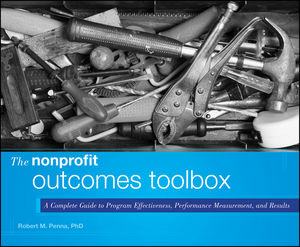NCFY Reads: 'The Nonprofit Outcomes Toolbox'
 “The Nonprofit Outcomes Toolbox: A Complete Guide to Program Effectiveness, Performance Measurement, and Results”
“The Nonprofit Outcomes Toolbox: A Complete Guide to Program Effectiveness, Performance Measurement, and Results”
by Robert M. Penna
In this guide, a family services professional and consultant for one of the nation’s leading charity evaluators helps nonprofits understand program performance measurement and evaluation. This book turns research jargon into plain language for staff at any level of your organization.
It’s a fact of life: Nonprofit programs, including youth-serving organizations, have to be able to show funders and the public that they really do improve the lives of the people they aim to help. But terms like “outcomes,” “effectiveness” and “performance” can seem like Greek to youth workers who got into the field simply because they love working with young people.
Robert Penna’s “The Nonprofit Outcomes Toolbox: A Complete Guide to Program Effectiveness, Performance Measurement, and Results” can serve as a textbook for managers and line staff who want to understand what all the fuss is about. Penna, a consultant for Charity Navigator, makes the case that an outcomes approach isn’t just about pleasing donors. It’s about making meaningful change in the world.
Not Every Accomplishment Is a Meaningful Outcome
Penna says that to make sure you’re aiming for the right kinds of changes in young people’s lives, you need to begin with a well-developed “outcomes statement” that describes the situation you intend youth to be in when your work with them has ended. He writes:
… a well-developed outcomes statement not only responds to the problem but adds value and is a positive improvement on the situation we wish to change. A meaningful change must alter the client or situation by replacing a negative behavior with a positive one; a self-destructing behavior is replaced with self-actualizing, a harmful condition is replaced with a protective one. A meaningful change will be able to show that useful knowledge has been absorbed and applied. Sustainable outcomes will continue to prove useful beyond the intervention.
Unless you’re an outcomes junkie, we recommend taking this book in small doses. One quick way to benefit from the book is to simply flip the pages and scan the margins, which include aphorisms, illustrations and contact information for the creators of management tools such as The RAND Corporation’s Getting to Outcomes and The Fiscal Policy Studies Institute’s 5-Step Process for Results-based Budgeting.
For visual and hands-on learners, Penna helpfully includes graphs, images and exercises that aim to give a clearer picture of the topic being discussed. For example, in Chapter 10, “Communicating Our Outcomes,” Penna explains the Scales and Ladders, or S&L, tool for tracking a particular set of variables. Penna uses the example of at-risk youth’s school attendance, literacy, job skills, socialization skills, and interest to show how the scale tracks progress over time and how that information can be used to determine outcomes.
Exercises like these are helpful to a youth worker who may not be knowledgeable about the concept of outcomes but does understand the “on the ground” realities of youth work.


 Sign up
Sign up Follow us
Follow us Like us
Like us Sign up for our RSS feeds:
Sign up for our RSS feeds: 

